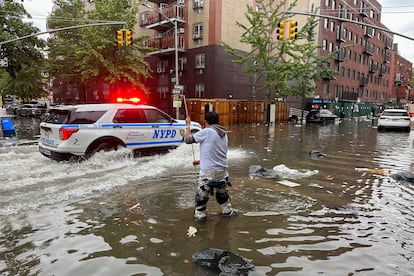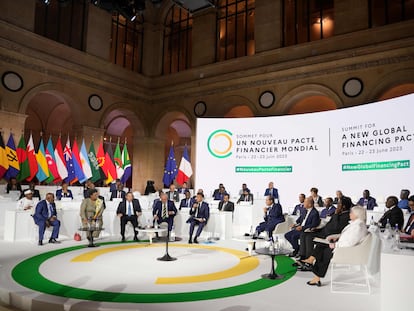Seeking funds for the green transition: Global debt could soar to 50% of GDP by 2050
The IMF calls for a carbon emissions trading scheme, mobilizing private finance and compensating the most vulnerable

The International Monetary Fund (IMF) is adamant that “we need to act urgently against climate change.” This will be the warmest year in history; in just five years, the average global temperature will be 1.5 degrees above pre-industrial levels, and the implications could be devastating: new diseases, more natural disasters and lower productivity. But the fund warns that meeting the challenge of reducing CO2 emissions to zero by 2050 will require an enormous fiscal effort. Specifically, it estimates that public debt will soar to between 45% and 50% of gross domestic product (GDP), rendering public finances unsustainable. The organization advocates setting up a system of carbon emission allowance costs, which 50 countries have already implemented, as well as deploying a host of measures, including the mobilization of private financing.
The burden of public debt will be the focus of the debate at the annual IMF and World Bank meetings, which will be held next week in Marrakech, Morrocco. Led by Kristalina Georgieva, the IMF has already released chapters from two of the main documents it will present on global financial stability. To this point, climate change has been identified as one of global finance’s biggest challenges. The IMF is finally estimating the figures for achieving full decarbonization by 2050 in black and white, based on the major premise that there is no alternative.
According to the IMF, the annual investment needed to achieve the 2050 targets will be around $5 trillion (€4.73 trillion) by 2030, especially in the countries with the highest carbon dioxide emissions. Practically 70% of this capital will have to go to the energy sector, which faces the challenge of moving away from fossil fuels. If financed with public capital, this amount would raise global public debt by between 45% and 50% of world GDP. According to a recent IMF study, the debt of public administrations around the world now stands at 92% of GDP. Despite slowing over the last two years, this is a historically high level because of the spending during the pandemic to save businesses and jobs. “High debt, rising interest rates and weaker growth prospects will make public finances even more difficult to balance,” the IMF report notes.
The IMF is calling on countries to take additional measures to reduce the pressure on public coffers. The fund argues that a carbon cost system should be the primary mechanism for achieving that. 50 countries have already adopted such a system and another 23 are considering doing so. In the European Union’s case, a mechanism is expected to be extended to include cars and buildings in the coming years. This tax has not been implemented at the federal level in the United States, although some states have adopted it.
However, the IMF is aware of the political cost that may be incurred if all policy action depends on such a tax. “Carbon pricing alone is not sufficient and should be complemented by other mitigation instruments to address market failures and promote innovation and deployment of low-carbon technologies,” the paper notes. " A pragmatic and equitable proposal calls for an international carbon price floor, differentiated across countries at different levels of economic development. The associated carbon revenues could be partly shared across countries to facilitate the green transition.”
The political “trilemma”
In fact, the Washington-based agency says that states face a “political trilemma” in achieving climate goals, fiscal sustainability and political viability. “In other words, pursuing any two of these objectives comes at the cost of partially sacrificing the third,” a blog post published this afternoon asserted. The institution therefore proposes “bold, swift, and coordinated action,” focusing on both spending and revenue, to forge ahead on emissions reductions. Among these measures, the IMF advocates “robust fiscal transfers to vulnerable households, workers, and communities.”
If the right formula can be found, the increase in debt can be limited to between 10% and 15% of GDP, although that will depend on the condition of the economy. In any case, the fund is pressuring the countries to act, not only because of the climate situation’s urgency, but also because delaying these steps only makes them more expensive. “Each year of delay is estimated to contribute between 0.8% and 2% to public debt,” the institution explains.
The IMF notes that this challenge is particularly significant for emerging countries, which account for 70% of polluting emissions. They already have high debt and rising interest rate costs. In this case, the organization proposes a broad package for more efficient spending, revenue mobilization, a greater role for the private sector and external financing. In fact, the IMF is offering to make long-term funds available through existing mechanisms. " No single country can solve the climate threat alone. Nor can the public sector act by itself. The private sector has to fulfill the bulk of the climate financing needs,” the report argues.
Follow all the information from Economy & Business on Facebook and X, or in our weekly newsletter.
Tu suscripción se está usando en otro dispositivo
¿Quieres añadir otro usuario a tu suscripción?
Si continúas leyendo en este dispositivo, no se podrá leer en el otro.
FlechaTu suscripción se está usando en otro dispositivo y solo puedes acceder a EL PAÍS desde un dispositivo a la vez.
Si quieres compartir tu cuenta, cambia tu suscripción a la modalidad Premium, así podrás añadir otro usuario. Cada uno accederá con su propia cuenta de email, lo que os permitirá personalizar vuestra experiencia en EL PAÍS.
¿Tienes una suscripción de empresa? Accede aquí para contratar más cuentas.
En el caso de no saber quién está usando tu cuenta, te recomendamos cambiar tu contraseña aquí.
Si decides continuar compartiendo tu cuenta, este mensaje se mostrará en tu dispositivo y en el de la otra persona que está usando tu cuenta de forma indefinida, afectando a tu experiencia de lectura. Puedes consultar aquí los términos y condiciones de la suscripción digital.
More information
Últimas noticias
Most viewed
- Sinaloa Cartel war is taking its toll on Los Chapitos
- Reinhard Genzel, Nobel laureate in physics: ‘One-minute videos will never give you the truth’
- Oona Chaplin: ‘I told James Cameron that I was living in a treehouse and starting a permaculture project with a friend’
- Why the price of coffee has skyrocketed: from Brazilian plantations to specialty coffee houses
- David King, chemist: ‘There are scientists studying how to cool the planet; nobody should stop these experiments from happening’











































